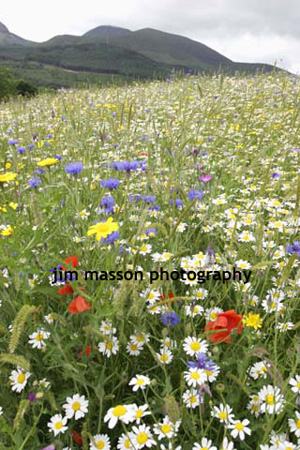Flower rich meadows and grasslands alive with fluttering butterflies and buzzing bees are less common than they were, but can still be found if you know where to look.
The National Trust’s Wildlife and Countryside Advisor, Phil Davidson is encouraging everyone to take a walk through some of Northern Ireland’s most beautiful and bounteous wildflower sites.

Phil said: “A walk through a meadow to see buttercups, vetches, clovers and speedwells in bloom can really lift the spirits. Wildflowers however are not simply pretty to look at but make a huge contribution to the health of other wildlife too. They attract a huge variety and number of pollinating insects including butterflies, such as meadow browns, small heaths and common blues, as well as hoverflies and bees.
“Take time this summer to celebrate our wildflower meadows and enjoy some of these special places throughout the season.”
Best places for wildflowers
At Rowallane Garden there is a host of native wildflowers nestling alongside trees and shrubs from around the world. The meadows come alive with the tiny white pignut in spring alongside the bluebells, followed by splashes of yellow in kidney vetch and bird’s-foot trefoil. Then starry whites of eyebright and chickweeds appear, with the pale pink spikes of the common spotted orchid arriving on mass in July. Sometimes the soft creams of the butterfly orchid and the unusual greenish flowers of the common twayblade orchids make an appearance, if the conditions suit them, and the purple haze of devil’s-bit scabious appear late summer.
Castle Coole hosts a number of flowers, grasses and sedges including knapweed, self-heal, oxeye daisy, plantain and orchids, including the rare greater butterfly orchid. These wildflowers have thrived following a change in the way the land is managed. Instead of being maintained as lawn, the meadows in front of the house and along the drive are now cut just once a year, giving the flowers a chance to flourish and set seed.
Crom offers up a host of wild flowers. In the damper meadows look out for butterfly orchid, common spotted orchid, marsh marigold, yellow flag iris, ragged robin, meadow sweet and marsh cinquefoil.
At Minnowburn, the meadows on the banks of the River Lagan come alive in the summer with buzzing insects darting here and there amongst the flowers. Meadowsweet, orchids, buttercups, yellow rattle and vetches are among the flowers and grasses that can be found, providing a home for moths, flies, bees and butterflies and a host of other wildlife.
Take a walk down by the Temple Water and Tullyratty at Castle Ward. On the banks of Temple Water look out for water lilies, yellow irises, meadowsweet, bogbean, water mint and reed canary grass. At Tullratty the herb rich grasslands form a mosaic amidst the gorse scrub. Look out for burnet saxifrage, knapweed, common ragwort, common spotted orchids, bird’s-foot trefoil, yellow meadow vetchling, devil’s-bit scabious and wild carrot.
Coastal sites with either sand dunes or exposed rocky slopes also provide some of the best places to see many varieties of wild flowers. White Park Bay and Giant’s Causeway are home to sea rocket, broomrape, frog orchid, meadow cranesbill, devil’s-bit scabious, twayblade, meadow vetchling, harebell, kidney vetch, lady’s bedstraw, pyramidal orchid and the common spotted orchid.
Portstewart sand dunes are grazed by cattle to get a perfect balance between fewer coarse grasses and more fine leaved grasses with many flowering herbs. It is a good place to see bee, pyramidal and northern marsh orchids.
While on the dunes at Murlough National Nature Reserve you can see heather, wood sage, bird’s-foot trefoil, St. John’s wort, rest harrow, wild pansy, tormentil, lady’s bedstraw, rest harrow and wild pansy.
National Meadows Day is Saturday 2 July and there will be an opportunity for all the family to join the rangers at Minnowburn to ‘Get mellow in the meadow’ from 11am to 12.30pm. Or join staff and many other naturalists at Murlough NNR on a wildlife journey of discovery to see wild flowers, buzzing bees and creepy crawlies at our ‘It’s only natural’ event, from dawn to dusk.

























